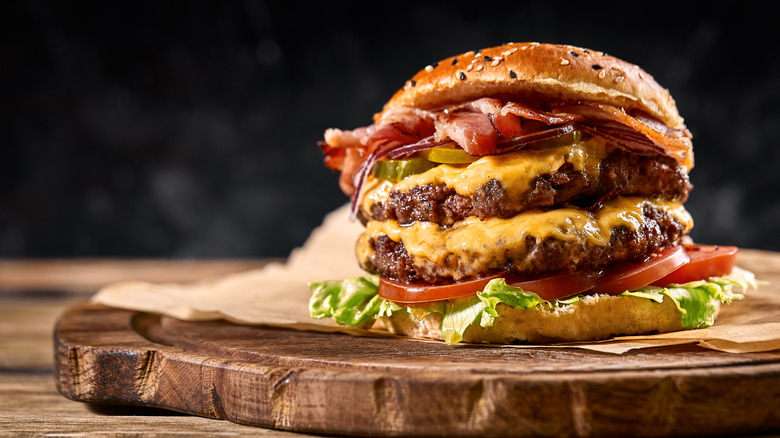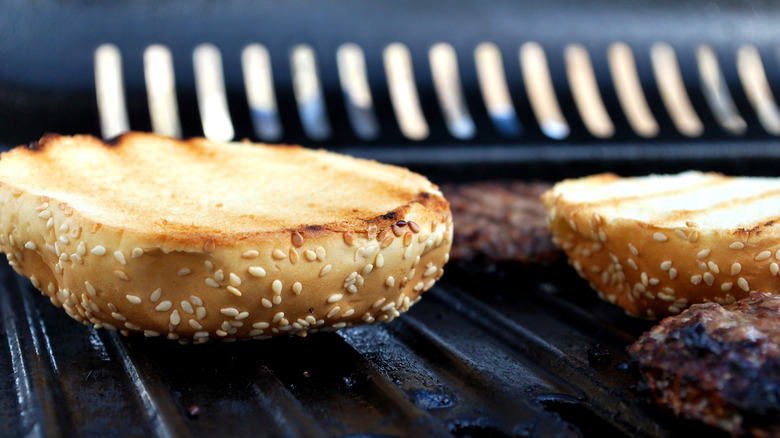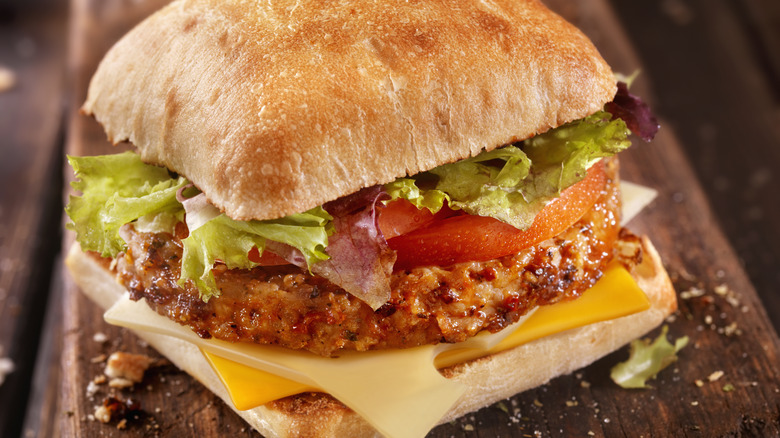The Simple Fix To Avoid A Soggy Burger Bun
For years, home grill masters have endeavored to build a better burger. One essential aspect of burger construction is preventing the bottom bun from becoming a soggy mess, which is an all-too-common occurrence. Fortunately, there's an easy fix for that: simply build a barrier between the bottom bun and your juicy burger by skillfully adding other elements.
When it comes to cheese, place the slice on top of the bottom bun, as opposed to on top of the burger. You can also spread mayo or mustard over the bottom bun if you're not a fan of cheeseburgers. In a Facebook post, celebrity chef Alton Brown explains that this works because fat is "hydrophobic" and thus repels liquids (like meat juices). He also notes that avocado works just as well. Next, you'll want to place a crisp piece of lettuce roughly the size of the bun and burger over the cheese or condiment of your choosing for added protection. These add-ons will intercept the juices from the meat and stop your carefully constructed sandwich from literally falling to pieces in your hands.
Because the best home chefs have more than one trick up their sleeves, you should also bone up on other great solutions for avoiding soggy bottom buns. There are a number of easy adjustments you can make in addition to the barrier trick that will help to fortify your burger.
Toast your buns to perfection
Toasting both the top and bottom bun offers two great benefits. A toasted bun is much crispier, which makes for a sturdier burger overall. Toasting a bun also infuses it with an amazing flavor that will elevate your burger to a whole new level. Accordingly, it's an essential component of building the perfect burger. The technique is even favored by chef Gordon Ramsay, who told Good Morning America that he considers it essential. "I'm a firm believer in toasting both sides of my bun," he said.
While there are lots of ways you can toast your buns, grilling them is the best option when it comes to cookouts. Your grill will already be nice and hot, and the bun will take on an unbelievable smoky flavor that can't be replicated in a toaster.
To get started, take your untoasted buns, and apply butter to both. It's best to allow the butter to warm up a bit if it's been in the fridge, as it will become nice and spreadable. Once the bun has been sufficiently buttered, place it on the grill butter side down. It won't take long for the bun to get toasted, so be sure to remove it ASAP to avoid burning. Of course, the type of bread that you choose can also play a huge role in the sturdiness of your burger.
The bread for a robust burger
With such a wide selection of burger buns, choosing the right option is usually a matter of personal taste. However, choosing a hearty type of bread can make all the difference to the stability of your burger. In this case, ciabatta is an excellent selection, both in terms of flavor and durability. For the uninitiated, ciabatta bread was created in Italy and is characterized by its dense, crusty nature. In fact, ciabatta was intended to be Italy's version of the baguette. The bread is also made with olive oil, which infuses it with a complex flavor that pairs beautifully with all types of recipes, including burgers.
The unique shape of ciabatta (the name means "slipper" in English) makes it perfect for burgers, and the bread also holds up well to being toasted. In this case, olive oil instead of butter is an excellent addition when grilling your ciabatta for burgers. And because ciabatta is a little denser than your average hamburger bun, you'll probably need to grill it from one to two minutes on both sides to achieve the perfect texture.


